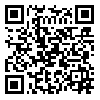Volume 78, Issue 1 (April 2020)
Tehran Univ Med J 2020, 78(1): 21-27 |
Back to browse issues page
Download citation:
BibTeX | RIS | EndNote | Medlars | ProCite | Reference Manager | RefWorks
Send citation to:



BibTeX | RIS | EndNote | Medlars | ProCite | Reference Manager | RefWorks
Send citation to:
Bolhasani F, Naghdi S, Nakhostin Ansari N, Fakhari Z. The immediate effects of dry needling for ankle and toe plantar flexors on spasticity and balance in patients with stroke. Tehran Univ Med J 2020; 78 (1) :21-27
URL: http://tumj.tums.ac.ir/article-1-10368-en.html
URL: http://tumj.tums.ac.ir/article-1-10368-en.html
1- Department of Physiotherapy, School of Rehabilitation, Tehran University of Medical Sciences, Tehran, Iran.
2- Department of Physiotherapy, School of Rehabilitation, Tehran University of Medical Sciences, Tehran, Iran. Neuromusculoskeletal Research Center, Iran University of Medical Sciences, Tehran, Iran. ,naghdi@tums.ac.ir
3- Department of Physiotherapy, School of Rehabilitation, Tehran University of Medical Sciences, Tehran, Iran. Sports Medicine Research Center, Neuroscience Institute, Tehran University of Medical Sciences, Tehran, Iran.
2- Department of Physiotherapy, School of Rehabilitation, Tehran University of Medical Sciences, Tehran, Iran. Neuromusculoskeletal Research Center, Iran University of Medical Sciences, Tehran, Iran. ,
3- Department of Physiotherapy, School of Rehabilitation, Tehran University of Medical Sciences, Tehran, Iran. Sports Medicine Research Center, Neuroscience Institute, Tehran University of Medical Sciences, Tehran, Iran.
Abstract: (2467 Views)
Background: Spasticity is one of the most important symptoms of stroke, which leads to movement constraints and disability. The presence of spasticity in the ankle and toe plantar flexor muscles disturbs the balance and gait of patients with stroke. Dry needling has been introduced as a new method for the treatment of spasticity. The aim of this study was to investigate the immediate effects of the ankle and toe plantar flexors dry needling on spasticity and balance in patients with stroke.
Methods: This study was a clinical pretest-posttest study. Twenty patients with stroke (12 males and 8 females), the mean age of 56.5±13 years were included. The assessments were performed before dry needling, immediately after dry needling and 15 minutes after that. Dry needling was used to treat gastrocnemius (ankle plantar flexor) muscles, flexor digitorum longus, and flexor digitorum brevis of the affected lower limb of the patients, for one session. Each muscle was needled for one minute with fast in-fast out technique. The outcome measures of the study were modified modified Ashworth scale (MMAS) for the assessment of the severity of muscle spasticity, timed up and go test and one leg stance test, for balance evaluation. The study was conducted in neurological physical therapy, Clinic of Rehabilitation School, Tehran University of Medical Sciences in Iran, from April 2017 to April 2018.
Results: The results showed a significant decrease in the ankle and toe plantar flexor muscles spasticity both immediately after dry needling and at 15 minutes follow-up (P=0.001). The duration of timed up and go test (P=0.001) and one leg stance test (P=0.001) improved significantly after dry needling and this improvement persisted for 15 minutes after dry needling. The effect size for timed up and go test and one leg stance test was small (Cohen'sd=0.33 and 0.32 respectively).
Conclusion: This study suggests that dry needling is effective in improving spasticity of ankle and toe plantar flexor muscles and the balance of patients with stroke. Further research with larger sample size and control group is necessary.
Methods: This study was a clinical pretest-posttest study. Twenty patients with stroke (12 males and 8 females), the mean age of 56.5±13 years were included. The assessments were performed before dry needling, immediately after dry needling and 15 minutes after that. Dry needling was used to treat gastrocnemius (ankle plantar flexor) muscles, flexor digitorum longus, and flexor digitorum brevis of the affected lower limb of the patients, for one session. Each muscle was needled for one minute with fast in-fast out technique. The outcome measures of the study were modified modified Ashworth scale (MMAS) for the assessment of the severity of muscle spasticity, timed up and go test and one leg stance test, for balance evaluation. The study was conducted in neurological physical therapy, Clinic of Rehabilitation School, Tehran University of Medical Sciences in Iran, from April 2017 to April 2018.
Results: The results showed a significant decrease in the ankle and toe plantar flexor muscles spasticity both immediately after dry needling and at 15 minutes follow-up (P=0.001). The duration of timed up and go test (P=0.001) and one leg stance test (P=0.001) improved significantly after dry needling and this improvement persisted for 15 minutes after dry needling. The effect size for timed up and go test and one leg stance test was small (Cohen'sd=0.33 and 0.32 respectively).
Conclusion: This study suggests that dry needling is effective in improving spasticity of ankle and toe plantar flexor muscles and the balance of patients with stroke. Further research with larger sample size and control group is necessary.
Type of Study: Original Article |
Send email to the article author
| Rights and permissions | |
 |
This work is licensed under a Creative Commons Attribution-NonCommercial 4.0 International License. |





